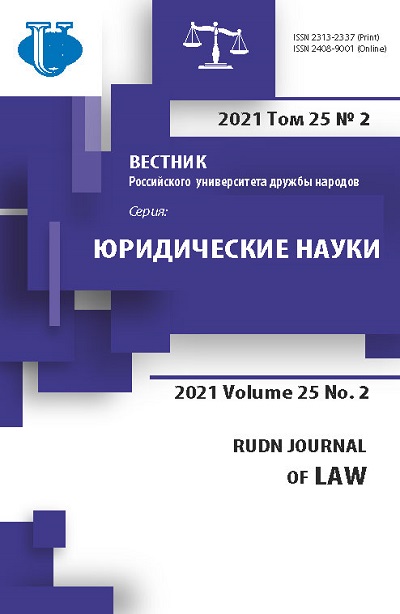Related rights: conceptual approaches, definition and key features
- Authors: Buzova N.V.1
-
Affiliations:
- Russian State University of Justice
- Issue: Vol 25, No 2 (2021)
- Pages: 541-561
- Section: CIVIL LAW
- URL: https://journals.rudn.ru/law/article/view/26713
- DOI: https://doi.org/10.22363/2313-2337-2021-25-2-541-561
- ID: 26713
Cite item
Full Text
Abstract
The development of technologies contributes to the emergence of new intangible objects that have potential value and are aimed at spreading the results of creativity and information. In this regard, the society is interested in encouraging the activities of entities that create such objects. One of the options for the protection of such objects is to grant the related rights. Considering the technological changes in society associated with the use of information and telecommunication networks and artificial intelligence, the issues of granting related rights to new entities gain relevance. In order to identify the possibility of expanding the institution of related rights and determine the directions of such expansion, the article analyzes the main approaches to the formation of the institute of related rights, their characteristics, and attempts to deliver a working definition of the concept of related rights. On the basis of a comparative analysis, the author considers Russian and foreign legislative acts in the field of intellectual property, international treaties on copyright and related rights, as well as legal literature. The most supported idea of the formation of the institute of related rights is the functional purpose of the activities of subjects of related rights, acting as intermediaries between authors and representatives of the public. However, the institute itself is evolving and recognition of related rights for new subjects depends not only on the functional purpose of the activity, but also on their organizational and/or economic contribution aimed at processing and disseminating works and information. It can be assumed that the institute of related rights will continue to expand with the development of technologies and the public demand for new services provided by new technologies.
About the authors
Natalia V. Buzova
Russian State University of Justice
Author for correspondence.
Email: nbuzova@yandex.ru
Candidate of Legal Sciences, Leading Researcher, Center for the Study of Justice Problems
69 Novocheremushkinskaya str., Moscow, 117418, Russian FederationReferences
- Belov, V.A. (2012) Civil law. Common part. Introduction to civil law. 2nd ed. Moscow, Yurayt Publ. (in Russian).
- Bliznets, I.A. & Leont'ev, K.B. (2015) Copyright and related rights. 2nd ed. Moscow, Prospekt Publ. (in Russian).
- Dozortsev, V.A. (2005) Intellectual rights. Concept. System. Codification tasks. Moscow, Statut Publ. (in Russian).
- Dworkin, G. & Taylor, R.D. (1989) Blackstone’s Guide to the copyright, designs and patents act 1988. London, Blackstone Press.
- Ficsor, M. (ed.) (2004) Guide to the copyright and related rights treaties administered by WIPO and glossary of copyright and related rights terms. WIPO Publication No. 891(E), Geneva, Switzerland.
- Frolova, O. (2007) Concept and legal nature of subjective related rights. Business and Law Journal. (7), 93-100. (in Russian).
- Gavrilov, E.P. (2003) Commentary on the Law on Copyright and Related Rights. Moscow, Ekzamen Publ. (in Russian).
- Gavrilov, E.P. (2015) Intellectual Property Law. General provisions. XXI century. Moscow, Yurservitum Publ. (in Russian).
- Hugenholtz, B.P. (2019) Neighbouring Rights are Obsolete. IIC. International Review of Intellectual Property and Competition Law. 50 (8), October. 1006-1011.
- Entin, V.L. (2018) Intellectual property in European Union law. Moscow, Statut Publ. (in Russian).
- Karanda, M. (2001) Functional features of the institute of related rights. Intellectual property. Copyright and related rights. (2), 30-41. (in Russian).
- Korshunov, N.M. & Jeriashvili, N.D. (eds.) (2017) Intellectual property right. 2nd ed. Moscow, JUNITI-DANA: Zakon i pravo Publ. (in Russian).
- Korshunov, N.M. & Haritonova, Ju.S. (eds.) (2017) Intellectual property (Rights to the results of intellectual activity and means of individualization). Moscow, Norma: INFRA M Publ. (in Russian).
- Kost'kova, O.V. (2005) Article-by-article commentary to the Federal Law “On Copyright and Related Rights”. Moscow, Novaya pravovaya kul'tura Publ. (in Russian).
- Kuznetsov, M.N. (1986) Protection of Copyright in Private International Law. Moscow, UDN Publ. (in Russian).
- Lipszyc, D. (2002) Copyright Law and Neighboring Rights. Moscow, Ladomir Publ. (In Russian).
- Matveev, A.G. (2019 a) The idea of related rights and their varieties. Journal of the Intellectual Property Court. (24), 54-60. (in Russian).
- Matveev, A.G. (2019 b) Continental and Anglo-American traditions of protection of related rights: general and different. Humanities, socio-economic and social sciences. (8), 126-129. (in Russian).
- Novoselova, L.A. (ed.) (2017) Intellectual Property Rights. T. 2. Copyright. Textbook. Moscow, Statut Publ. (in Russian).
- Ogawa, M. (2006) Protection of Broadcasters' Rights. Leiden/Boston. Martinus Nijhoff Publishers. The Netherlands.
- Sсhack, H. (2001) Urheber- und Urhebervertragsrecht. 2. Aufl., Tubingen. Mohr Siebeck. Deutschland. (in German).
- Serebrovskiy, V.I. (1956) Issues of Soviet Copyright Law. Moscow, AN SSSR Publ. (in Russian).
- Stolz, F. (1986) Die Rechte der Sendeunternehmen nach Inkrafttretten der Urheberrechtsnovelle von 1985. GRUR. (12), 859-864. (in German).
- Suhanov, E.A. (ed.) (2015) Russian civil law: General part. Property law. Inheritance law. Intellectual rights. Personal non-property rights. 4th ed. Moscow, Statut Publ. (in Russian).
- Zenin, I.A. (2019) Intellectual property law. 10th ed. Moscow, Yurayt Publ. (in Russian)
- Zenin, I.A. (2013) Origin and development of the Institute of related rights in the Russian Federation. Intellectual property law. (1). 3-11. (in Russian)
Supplementary files















